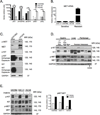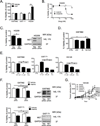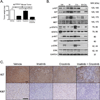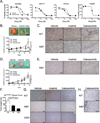Pharmacological Inhibition of KIT Activates MET Signaling in Gastrointestinal Stromal Tumors
- PMID: 25836719
- PMCID: PMC4467991
- DOI: 10.1158/0008-5472.CAN-14-2564
Pharmacological Inhibition of KIT Activates MET Signaling in Gastrointestinal Stromal Tumors
Abstract
Gastrointestinal stromal tumors (GIST) are the most common adult sarcomas and the oncogenic driver is usually a KIT or PDGFRA mutation. Although GISTs are often initially sensitive to imatinib or other tyrosine kinase inhibitors, resistance generally develops, necessitating backup strategies for therapy. In this study, we determined that a subset of human GIST specimens that acquired imatinib resistance acquired expression of activated forms of the MET oncogene. MET activation also developed after imatinib therapy in a mouse model of GIST (KitV558del/+ mice), where it was associated with increased tumor hypoxia. MET activation also occurred in imatinib-sensitive human GIST cell lines after imatinib treatment in vitro. MET inhibition by crizotinib or RNA interference was cytotoxic to an imatinib-resistant human GIST cell population. Moreover, combining crizotinib and imatinib was more effective than imatinib alone in imatinib-sensitive GIST models. Finally, cabozantinib, a dual MET and KIT small-molecule inhibitor, was markedly more effective than imatinib in multiple preclinical models of imatinib-sensitive and imatinib-resistant GIST. Collectively, our findings showed that activation of compensatory MET signaling by KIT inhibition may contribute to tumor resistance. Furthermore, our work offered a preclinical proof of concept for MET inhibition by cabozantinib as an effective strategy for GIST treatment.
©2015 American Association for Cancer Research.
Conflict of interest statement
The authors have no financial conflict of interest.
Figures





Similar articles
-
The Novel HSP90 inhibitor, IPI-493, is highly effective in human gastrostrointestinal stromal tumor xenografts carrying heterogeneous KIT mutations.Clin Cancer Res. 2011 Sep 1;17(17):5604-14. doi: 10.1158/1078-0432.CCR-11-0562. Epub 2011 Jul 7. Clin Cancer Res. 2011. PMID: 21737509
-
Cabozantinib Is Active against Human Gastrointestinal Stromal Tumor Xenografts Carrying Different KIT Mutations.Mol Cancer Ther. 2016 Dec;15(12):2845-2852. doi: 10.1158/1535-7163.MCT-16-0224. Epub 2016 Oct 24. Mol Cancer Ther. 2016. PMID: 27777285
-
Gastrointestinal stromal tumors.Curr Top Microbiol Immunol. 2012;355:41-57. doi: 10.1007/82_2011_161. Curr Top Microbiol Immunol. 2012. PMID: 22015552 Review.
-
The HSP90 inhibitor, AT13387, is effective against imatinib-sensitive and -resistant gastrointestinal stromal tumor models.Mol Cancer Ther. 2012 Aug;11(8):1799-808. doi: 10.1158/1535-7163.MCT-11-1046. Epub 2012 Jun 19. Mol Cancer Ther. 2012. PMID: 22714264 Free PMC article.
-
The role of KIT in the management of patients with gastrointestinal stromal tumors.Hum Pathol. 2007 May;38(5):679-87. doi: 10.1016/j.humpath.2007.03.001. Hum Pathol. 2007. PMID: 17437861 Review.
Cited by
-
The V654A second-site KIT mutation increases tumor oncogenesis and STAT activation in a mouse model of gastrointestinal stromal tumor.Oncogene. 2020 Dec;39(49):7153-7165. doi: 10.1038/s41388-020-01489-4. Epub 2020 Oct 6. Oncogene. 2020. PMID: 33024275 Free PMC article.
-
Insights into the Pathogenesis of NF1-Associated Neoplasms.JID Innov. 2021 Sep;1(3):100044. doi: 10.1016/j.xjidi.2021.100044. Epub 2021 Aug 20. JID Innov. 2021. PMID: 34604833 Free PMC article.
-
Wnt/β-catenin Signaling Contributes to Tumor Malignancy and Is Targetable in Gastrointestinal Stromal Tumor.Mol Cancer Ther. 2017 Sep;16(9):1954-1966. doi: 10.1158/1535-7163.MCT-17-0139. Epub 2017 Jun 13. Mol Cancer Ther. 2017. PMID: 28611108 Free PMC article.
-
In Vivo Evaluation of Fibroblast Growth Factor Receptor Inhibition in Mouse Xenograft Models of Gastrointestinal Stromal Tumor.Biomedicines. 2022 May 13;10(5):1135. doi: 10.3390/biomedicines10051135. Biomedicines. 2022. PMID: 35625872 Free PMC article.
-
E3 ubiquitin ligase Atrogin-1 mediates adaptive resistance to KIT-targeted inhibition in gastrointestinal stromal tumor.Oncogene. 2021 Dec;40(48):6614-6626. doi: 10.1038/s41388-021-02049-0. Epub 2021 Oct 7. Oncogene. 2021. PMID: 34621020
References
-
- Hirota S, Isozaki K, Moriyama Y, Hashimoto K, Nishida T, Ishiguro S, et al. Gain-of-function mutations of c-kit in human gastrointestinal stromal tumors. Science. 1998;279:577–580. - PubMed
-
- Heinrich MC, Corless CL, Duensing A, McGreevey L, Chen CJ, Joseph N, et al. PDGFRA activating mutations in gastrointestinal stromal tumors. Science. 2003;299:708–710. - PubMed
Publication types
MeSH terms
Substances
Grants and funding
LinkOut - more resources
Full Text Sources
Molecular Biology Databases
Miscellaneous

